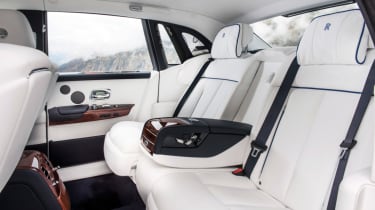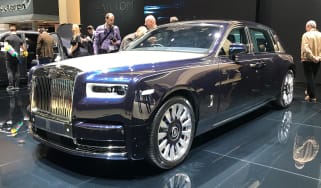Rolls-Royce Phantom review
The new Rolls-Royce Phantom offers wealthy owners the ultimate in luxury, comfort and opulence

For some luxury car buyers, the Rolls-Royce Phantom is too ostentatious, for others it’s just too big – but most simply can’t afford one. Clear all those hurdles though, and you’re in for a treat, as there is no other car on the planet that can match the opulence, superlative ride comfort and hushed refinement of this remarkable Rolls-Royce flagship. It’s an absolute pleasure behind the wheel too, with effortless performance from a big V12 engine and a chassis that welcomes spirited driving.
The tech-laden Phantom uses all the ingenuity and expertise of the BMW Group and its suppliers, and the spec-sheet wants for nothing when it comes to latest active safety features and infotainment systems. The rest is up to you, with a limitless array of colour, trim and option choices. It all comes at a price, of course.
The Rolls-Royce Phantom has a price tag that means it costs more than the average house for sale in the UK. It's expensive by anybody's estimation, but buyers that can afford it get to experience an interior that's one of the most luxurious places of all to spend time anywhere, let alone in the world of cars.
This version is the Phantom 8, which was introduced in 2017 as the second Phantom to be produced by the company since its ownership by BMW. As a result, there is BMW technology under the skin, but the essence that makes a Rolls-Royce is still in place, courtesy of its hand-built nature at the company's factory in Goodwood, West Sussex.
Used - available now

2022 Rolls-Royce
Phantom
23,000 milesAutomaticPetrol6.8L
Cash £249,995There aren't really any rivals to the Rolls-Royce Phantom. With prices starting in excess of £300,000, it really is a car in a field of one. The Bentley Mulsanne is 'cheap' at around £230,000, while cars like the Mercedes S-Class, Audi A8 and BMW 7 Series (which uses similar running gear to the Phantom) are positively bargain basement in comparison. You could argue that the Phantom's closest opposition comes from within, as the Rolls-Royce Cullinan uses the same tech as the Phantom, but wraps everything in an SUV body.
From the outside, the Phantom has a look that's evolutionary from the previous generation. It's still huge and imposing, but it's slightly less brutish than before. It's also lighter than its predecessor in a nod to improved efficiency.
You still get rear-hinged doors to boost access to the back seats, and once there, the interior is as plush as can be, with plenty of soft leather, beautifully finished wood and metal trim and plenty of bespoke options if you've specced your Phantom from scratch.
Away from the interior, the Phantom sees BMW's latest technology under the skin. There's an aluminium chassis, and a 6.75-litre twin-turbo V12 designed to deliver effortless power in near silence. Then there are the electronics, including active air suspension, four-wheel steering and surround view cameras, among other highlights.
As before, there are standard and extended wheelbase options, and while the initial price is steep, it can escalate even further once you choose exactly how you want your luxury car to look inside and out.
Engines, performance and drive
The Rolls-Royce Phantom was engineered to offer the most comfortable and refined driving experience of any car on sale. As a result of this focus, the Phantom’s greatest strength is a superb level of refinement and comfort, which best complements a somewhat stately driving style.
On top of the usual on-board sensors that allow the suspension to independently correct the dampers to deal with road imperfections, the Phantom deploys a camera system called Flagbearer that can ‘read’ the road surface ahead at speeds of up to 60mph. It pre-sets the dampers to optimise efficiency over bumps, before the car even meets them.
Meanwhile, the Phantom’s passengers are cossetted in a whisper-quiet cabin that offers truly remarkable refinement, thanks to a substantial increase in sound-deadening material. The specially developed tyres have foam inside them to reduce road roar and the engine is barely audible, too.
Given the superlative comfort on offer, it’s all the more impressive that the Phantom can display remarkable composure when asked to proceed at speed, even if one could never call it sporty. It feels wieldy though, in spite of its size. Excellent body control, impressive grip from the front tyres and the unique ‘finger-tip’ feel of the big steering wheel rim mean the driver can place the Phantom confidently when driving with verve on more challenging roads.
Performance is mighty yet effortless, with no need to rev the engine to access a fabulous whoosh of acceleration, while the eight-speed auto transmission changes gears almost imperceptibly to heighten the ‘other-worldliness’ of the Rolls-Royce flagship’s on-road prowe
Engines
The big 6.75-litre V12 engine under the Phantom’s prominent bonnet is a revised version of the 6.6-litre unit fitted to the smaller Rolls-Royce Ghost. It makes the same 536bhp as in the Ghost, along with a humungous 900Nm of torque delivered from just 1,700rpm. It’s enough to accelerate the Phantom from 0-62mph in 5.3 seconds, though top speed is limited to a very dignified 155mph.
MPG, CO2 and Running Costs
When the average UK house price is £225,000, an ability to spend the £360k required to buy even the most simply-specified Rolls-Royce Phantom is something most of us will only ever dream of. But Rolls-Royce Motor Cars operates in such a rarefied atmosphere that it’s only the starting point, Phantom customers will very often order bespoke options, trims and upholstery finishes that push the price of their cars towards the £1million mark.
While rock stars and lottery winners may still deal in hard cash, a few Phantoms will be leased on monthly payments. This means owners effectively only pay for depreciation, so their capital can be invested in projects that won’t haemorrhage value the way a luxury car loses money when driven off the forecourt.
In that sort of environment, it’s clear that fuel economy is never going to be an issue, but even so, the 20mpg this car is capable of (even under the tougher WLTP test method), isn’t too disgraceful for a machine weighing two and a half tonnes.
Use anything of the available performance though, and that figure will plummet. Naturally, the officially quoted CO2 figure of 318g/km is going to be a lot worse when you’re guzzling unleaded, too. Interestingly, going for the Extended Wheelbase Phantom only sees emissions rise to 319g/km.
On the plus side, at least road tax is no longer emissions based after the first year, and the Phantom will be no more expensive than its lower priced rivals in that regard. Of course, in the first year, the Phantom is liable for the maximum surcharge in excess of £2,000.
Insurance groups
Insurance costs will be in the top Group 50, but most Phantom owners are likely to have ‘fleet’ policies covering multiple vehicles in their garages.
Depreciation
Depreciation on a Rolls-Royce Phantom is a vague affair, especially as there are so many variables in how cars are used and how they are specified when new. However, the previous generation Phantom should be a useful guide, and we reported a while back on depreciation levels of around 25 per cent in the first year. On a lavishly specified car that could be a very big number.
To get an accurate valuation on a specific model check out our free car valuation tool...
Interior, design and technology
While the Phantom VIII is an evolutionary design, it’s quite easy to tell apart from its predecessor. The most obvious difference is the prominent grille, which on the newer car is a little wider and sits flush with the car body. On the Phantom Mk VII it stands proud of the bodywork.
Other external changes include headlamps with LED outlines, more upright front wings and a bonnet that has lost its pronounced central ‘vee’. At the rear of the car, the haunches are a little more tightly sculpted, and there’s a chamfered rear bumper. The side view retains the Phantom’s familiar profile though, and also the conjoined effect of the central door handles, and the iconic RR wheel centres that stay upright as the car drives.
The wide-opening doors reveal a sumptuously leather-trimmed cabin (assuming you’ve not ordered an even more exotic bespoke finish) while the rears close behind you at the touch of a button. The frankly ridiculous 6mm double-glazing ensures you’re isolated from any unpleasant urban or traffic noise, and you can sink your toes into the deep lamb’s wool carpet and enjoy your individually controlled climate settings on the armrests.
Up front, while there’s no shortage of new technology, but it’s the cabinet-like quality of the fascia that draws the attention – especially now there’s an art ‘gallery’ sitting on top of it. That’s the name Rolls-Royce gives to the sweeping expanse of glass that traverses the dash, behind which the manufacturer suggests the owner can commission and display their very own artworks for the ultimate in bespoke.
‘Traditional’ Rolls-Royce elements like the organ-stop switchgear and eyeball vents are retained, and every surface is finished to an impeccable standard in wood, metal or leather.
Sat-nav, stereo and infotainment
The Rolls-Royce Phantom’s infotainment system has taken a great leap forward in the latest generation car, and as well as a 12.3-inch wide TFT virtual instrument pack there’s a 7.3-inch colour head-up display, plus an enormous central TFT display screen that retracts into the dash when not required. With an iDrive style controller that can also be hidden in the central armrest, the system impressively blends a futuristic feel with the timeless craftsmanship on display elsewhere.
The Phantom’s audio quality is also notably impressive, with the listening experience heightened by the silence of the car’s cabin.
Practicality, comfort and boot space
If there’s a more comfortable way to travel than in any of the chairs in the new Rolls-Royce Phantom, it hasn’t been invented yet. The pure opulence of the Phantom’s spacious interior, coupled to its amazing whisper-quiet refinement and featherbed ride quality, mean it’s hard to imagine how things could be meaningfully improved.
Passengers in the rear benefit from luxurious practical touches like fold-down picnic tables, which are just as useful for laptops as they are for cheese and pickle sandwiches. You’ll also find individual climate control knobs, massaging seat options and personal infotainment screens – so it’s hard to imagine getting bored on a journey. If you’re worried, you can always order the on-board Champagne chiller and a pair of crystal glasses.
In fact, there are several different seating configurations available for the rear of the Phantom. A standard bench, individual chairs with a central console or armrests, and reclining ‘sleep seats’ for serious relaxation on the move.
Dimensions and size
The latest Phantom is actually a few millimetres shorter than its predecessor at 5,762mm overall. But you can still choose the extended wheelbase Phantom, which is 5,982mm nose-to-tail. With a roofline that’s 1,646mm off the ground, the driving viewpoint is not far off that of a full-size SUV and you’ll definitely look down on drivers of more hum-drum models.
Leg room, head room & passenger space
As you would expect from the Rolls-Royce flagship, there’s a fantastic amount of space for front and rear occupants, even in the standard wheelbase Phantom. With an extra 220m of rear legroom, the extended wheelbase version offers room for a party.
Boot space
The long-nose, and set-back cabin of the previous Phantom meant the car came in for a bit of criticism over its relatively small boot. The new version retains the iconic proportions, but engineers have made room for more of your luggage. Boot volume is up from 460 to 548 litres, which is said to be enough for four full-size golf bags.
Reliability and Safety
There’s little chance of Euro NCAP crash-testing the Phantom any time soon (nor the BMW 7 Series that shares much of the same technology), but the car’s massively rigid aluminium space-frame structure and sheer bulk means it’s likely to perform well if the worst happens. There’s a full complement of airbags and passive safety features, while the array of new technology includes night vision, collision and lane-departure warnings. Active cruise control and a head-up display are all part of the safer driving narrative too.
Rolls-Royce famously refuses to acknowledge the concept of breakdowns, but it does admit to the occasional ‘failure to proceed’. The Phantom is crammed to the gunwales with hi-tech kit that could go wrong, but the previous model has an admirable reliability record. Looking at the attention to detail that’s been lavished on the latest model’s design and build quality, it’s hard to imagine that significant problems will arise this time around.
Warranty
When you buy a Rolls-Royce of any kind these days, it comes with a four-year unlimited-mileage warranty and inclusive servicing cover. It means the costs of all repairs are covered, as well as all ‘consumable items’ apart from tyres. That means lubricants, filters, and brake components are included, for ultimate peace of mind.
Servicing
You needn’t worry about service intervals for the Phantom, as the car has on-board tech to tell you when it needs a trip to the dealership. In fact, the Phantom even monitors the state of its oil, brake pads and filters, and uploads the data automatically to the dealer network so all aspects of maintenance can be taken care of - there's potential that your local dealership will know that your Phantom will need a service before you're aware of it.





























